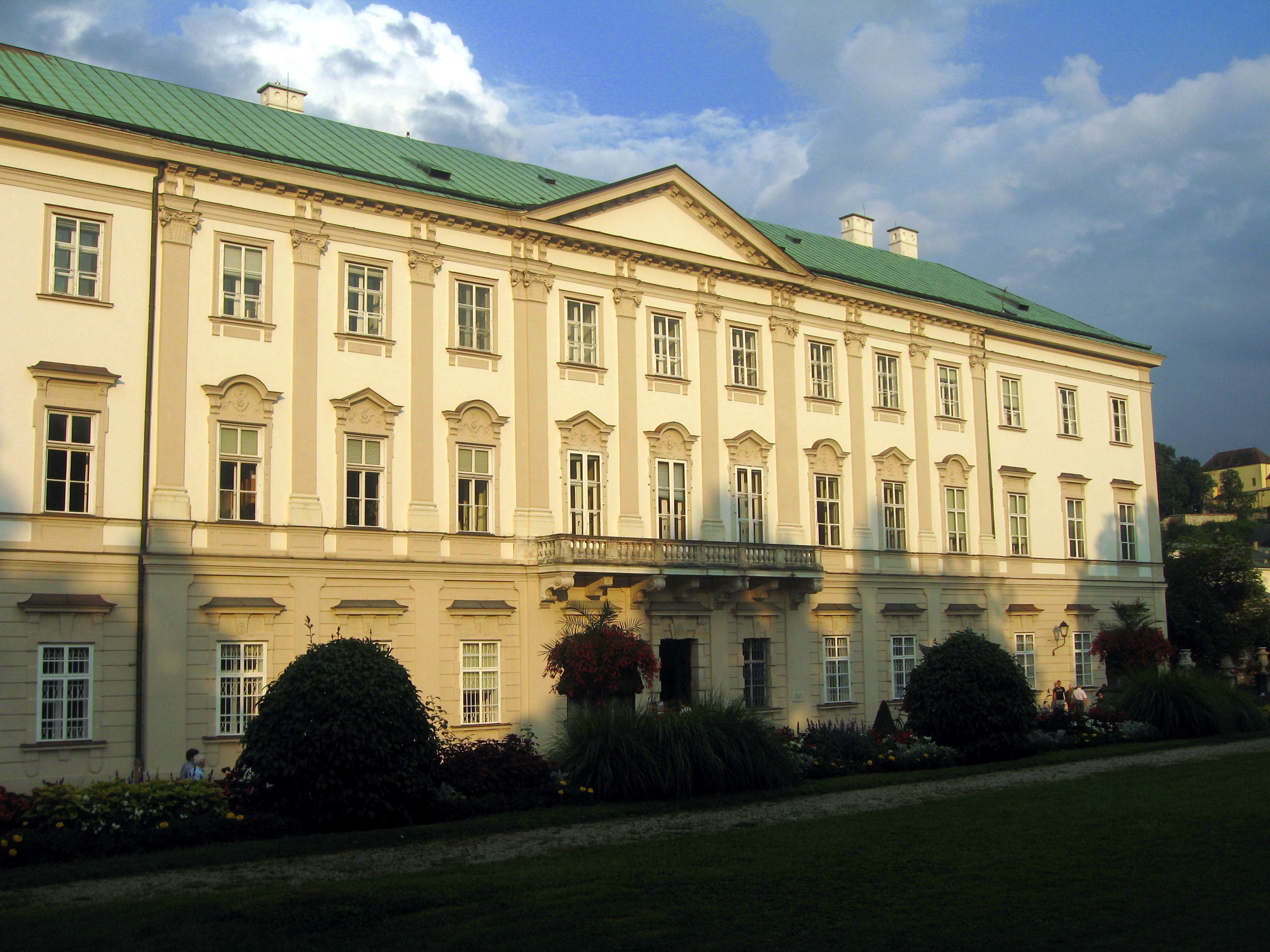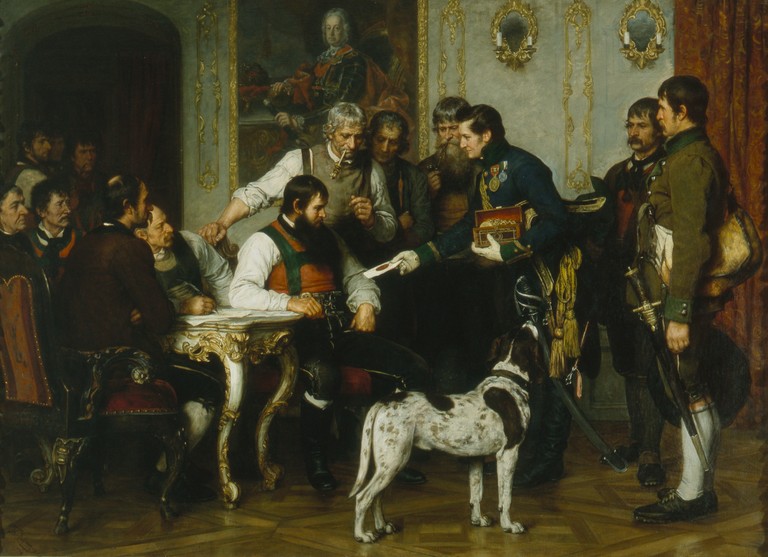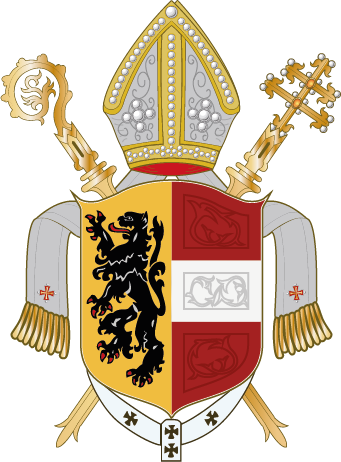|
Palace Of Mirabell
Mirabell Palace (german: Schloss Mirabell) is a historic building in the city of Salzburg, Austria. The palace with its gardens is a listed cultural heritage monument and part of the Historic Centre of the City of Salzburg UNESCO World Heritage Site. History The palace was built about 1606 on the shore of the Salzach river north of the medieval city walls, at the behest of Prince-Archbishop Wolf Dietrich Raitenau. The Archbishop suffered from gout and had a stroke the year before; to evade the narrow streets of the city, he decided to erect a pleasure palace for him and his mistress Salome Alt. Allegedly built within six months according to Italian and French models, it was initially named Schloss Altenau. When Raitenau was deposed and arrested at Hohensalzburg Castle in 1612, his successor Mark Sittich von Hohenems expelled Salome Alt and her family from the premises. Mark Sittich gave the palace its current name from it, mirabile, ''bella'': "amazing", "wonderful". It was r ... [...More Info...] [...Related Items...] OR: [Wikipedia] [Google] [Baidu] |
Otto Of Greece
Otto (, ; 1 June 181526 July 1867) was a Bavarian prince who ruled as King of Greece from the establishment of the monarchy on 27 May 1832, under the Convention of London, until he was deposed on 23 October 1862. The second son of King Ludwig I of Bavaria, Otto ascended the newly created throne of Greece at age 17. His government was initially run by a three-man regency council made up of Bavarian court officials. Upon reaching his majority, Otto removed the regents when they proved unpopular with the people, and he ruled as an absolute monarch. Eventually his subjects' demands for a constitution proved overwhelming, and in the face of an armed (but bloodless) insurrection, Otto granted a constitution in 1843. Throughout his reign Otto was unable to resolve Greece's poverty and prevent economic meddling from outside. Greek politics in this era were based on affiliations with the three Great Powers that had guaranteed Greece's independence, Britain, France and Russia, and Ot ... [...More Info...] [...Related Items...] OR: [Wikipedia] [Google] [Baidu] |
Luz Leskowitz
Luz Leskowitz (born 7 August 1943) is an Austrian violinist, founder of the Salzburg Soloists music ensemble. He is an owner of the ex-Prihoda Stradivarius violin made in 1707.Cozio.com: violin by Antonio Stradivari, 1707 (In English) Club-Carriere Luz Leskowitz (In German) /ref> Early career Leskowitz was born in Salzburg into a family of musicians. He began playing violin at the age of six. At age thirteen he moved to |
World War II
World War II or the Second World War, often abbreviated as WWII or WW2, was a world war that lasted from 1939 to 1945. It involved the vast majority of the world's countries—including all of the great powers—forming two opposing military alliances: the Allies and the Axis powers. World War II was a total war that directly involved more than 100 million personnel from more than 30 countries. The major participants in the war threw their entire economic, industrial, and scientific capabilities behind the war effort, blurring the distinction between civilian and military resources. Aircraft played a major role in the conflict, enabling the strategic bombing of population centres and deploying the only two nuclear weapons ever used in war. World War II was by far the deadliest conflict in human history; it resulted in 70 to 85 million fatalities, mostly among civilians. Tens of millions died due to genocides (including the Holocaust), starvation, ma ... [...More Info...] [...Related Items...] OR: [Wikipedia] [Google] [Baidu] |
Tyrolean Rebellion
The Tyrolean Rebellion (german: Tiroler Volksaufstand) is a name given to the resistance of militiamen, peasants, craftsmen and other civilians of the County of Tyrol led by Andreas Hofer supported by his wife Anna and a strategic council consisting of Josef Speckbacher, Peter Mayr, Capuchin Father Joachim Haspinger, Major Martin Teimer and Kajetan Sveth, against new legislation and a compulsory vaccination programme concerning smallpox ordered by king Maximilian I of Bavaria, followed by the military occupation of their homeland by troops organised and financed by Napoleon I of the First French Empire and Maximilian I. The broader military context is called the War of the Fifth Coalition. Backgrounds Governing and military situation In September 1805 the Electorate of Bavaria under Prince-elector Maximilian I Joseph of Wittelsbach, that had been allied with the Habsburg monarchy under the common federally structured Holy Roman Empire, went over to Napoleonic France: th ... [...More Info...] [...Related Items...] OR: [Wikipedia] [Google] [Baidu] |
Order Of Friars Minor Capuchin
The Order of Friars Minor Capuchin (; postnominal abbr. O.F.M. Cap.) is a religious order of Franciscan friars within the Catholic Church, one of Three " First Orders" that reformed from the Franciscan Friars Minor Observant (OFM Obs., now OFM), the other being the Conventuals (OFM Conv.). Franciscans reformed as Capuchins in 1525 with the purpose of regaining the original Habit (Tunic) of St. Francis of Assisi and also for returning to a stricter observance of the rule established by Francis of Assisi in 1209. History Origins The Order arose in 1525 when Matteo da Bascio, an Observant Franciscan friar native to the Italian region of Marche, said he had been inspired by God with the idea that the manner of life led by the friars of his day was not the one which their founder, St. Francis of Assisi, had envisaged. He sought to return to the primitive way of life of solitude and penance, as practised by the founder of their Order. His religious superiors tried to suppress ... [...More Info...] [...Related Items...] OR: [Wikipedia] [Google] [Baidu] |
Joachim Haspinger
Johann Simon Haspinger (28 October 1776 – 12 January 1858) was a Capuchin priest and a leader of the Tyrolean Rebellion against the French and Bavarian occupation forces during the Napoleonic War of the Fifth Coalition. External links Johann Simon Haspinger– Catholic Encyclopedia The ''Catholic Encyclopedia: An International Work of Reference on the Constitution, Doctrine, Discipline, and History of the Catholic Church'' (also referred to as the ''Old Catholic Encyclopedia'' and the ''Original Catholic Encyclopedia'') i ... article References 1776 births 1858 deaths People from Gsies 19th-century Austrian Roman Catholic priests {{austria-bio-stub ... [...More Info...] [...Related Items...] OR: [Wikipedia] [Google] [Baidu] |
Hans Makart
Hans Makart (28 May 1840 – 3 October 1884) was a 19th-century Austrian academic history painter, designer, and decorator. Makart was a prolific painter whose ideas significantly influenced the development of visual art in Austria-Hungary, Germany, and beyond. Life Makart was the son of a chamberlain at the Mirabell Palace, born in the former residence of the prince-archbishops of Salzburg, the city in which Mozart had been born. Initially, he received his training in painting at the Vienna Academy between 1850 and 1851 from Johann Fischbach. While in the Academy, German art was under the rule of a classicism, which was entirely intellectual and academic—clear and precise drawing, sculpturesque modelling, and pictorial erudition were esteemed above all. Makart, who was a poor draughtsman, but who had a passionate and sensual love of color, was impatient to escape the routine of art school drawing. For his fortune, he was found by his instructors to be devoid of all talent and ... [...More Info...] [...Related Items...] OR: [Wikipedia] [Google] [Baidu] |
Maximilian Joseph Von Tarnóczy
Maximilian Joseph von Tarnóczy (Hungarian: Tarnózy Miksa) (24 October 1806 – 4 April 1876) was an Austrian Cardinal and Archbishop. He was born in Schwaz on 24 October 1806, the son of Franz Xaver von Tarnóczy (Tarnóczy Ferenc), a Hungarian-Bavarian nobleman (1756–1837) and his second wife, Catherine von Sprinzenberg (1776–1837). He studied in Innsbruck and Salzburg and in 1829 became a priest. In 1832 he received a doctorate in theology and worked as a teacher at the Salzburg Lyceum. In 1850 he was appointed Archbishop of Salzburg, a position he held until his death in 1876. As Archbishop of Salzburg, Tarnóczy wielded huge power in Rome, so much so that when he arrived at the First Vatican Council, Pope Pius IX welcomed him with the words, ''"Ecco il mezzo papa, che puo far dei vescovi"'' (''"See the demi-Pope, who can make Bishops"''). The Archbishop of Salzburg had the power to ordain and consecrate the Bishop of Gurk; a power Tarnóczy exercised when he consecra ... [...More Info...] [...Related Items...] OR: [Wikipedia] [Google] [Baidu] |
Neoclassical Architecture
Neoclassical architecture is an architectural style produced by the Neoclassical movement that began in the mid-18th century in Italy and France. It became one of the most prominent architectural styles in the Western world. The prevailing styles of architecture in most of Europe for the previous two centuries, Renaissance architecture and Baroque architecture, already represented partial revivals of the Classical architecture of ancient Rome and (much less) ancient Greek architecture, but the Neoclassical movement aimed to strip away the excesses of Late Baroque and return to a purer and more authentic classical style, adapted to modern purposes. The development of archaeology and published accurate records of surviving classical buildings was crucial in the emergence of Neoclassical architecture. In many countries, there was an initial wave essentially drawing on Roman architecture, followed, from about the start of the 19th century, by a second wave of Greek Revival architec ... [...More Info...] [...Related Items...] OR: [Wikipedia] [Google] [Baidu] |
Electorate Of Salzburg
The Electorate of Salzburg (german: Kurfürstentum Salzburg or ), occasionally known as the Grand Duchy of Salzburg, was an electoral principality of the Holy Roman Empire from 1803–05, the short-lived successor state of the Prince-Archbishopric of Salzburg. History In 1800 the territory of the Prince-Archbishopric had been occupied by French forces during the War of the Second Coalition, whereby Archbishop Count Hieronymus von Colloredo fled to Vienna. Augmented by the Berchtesgaden Provostry and parts of the former prince-bishoprics of Eichstätt and Passau, his lands were reorganized as the Electorate of Salzburg, created for Ferdinand III of Habsburg-Lorraine, younger brother of Emperor Francis II. Ferdinand had held the Grand Duchy of Tuscany until 1801, when Emperor Francis had to cede the rule over Tuscany to France and Louis of Bourbon-Parma according to the Treaty of Lunéville. The Grand Duke, on good terms with Napoleon, reached his compensation with the f ... [...More Info...] [...Related Items...] OR: [Wikipedia] [Google] [Baidu] |







_-_facade_on_Piazza_dei_signori.jpg)
